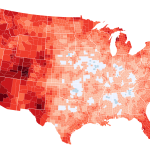The South is rising, not just in political influence, but also in its appeal to college students. A significant shift is underway, with a noticeable increase in students from the North trading snow for sunshine and ivy-covered walls for Southern charm. This northward migration isn’t merely a trend; it represents a profound change in the landscape of higher education in the United States.
The Allure of Southern Campuses
Between 2018 and 2022, a staggering 30 percent increase was observed in the number of students leaving Northern states for Southern universities. While the reasons are multifaceted, several factors contribute to this southward surge. Large public universities in the South, such as the University of Alabama and the University of Mississippi, boast vibrant campus cultures, often highlighted by robust Greek life and a passionate devotion to college football. This creates an attractive social environment for prospective students seeking a lively and engaged college experience. The appeal extends beyond the social scene; some argue that Southern institutions may have offered a more relaxed approach to COVID-19 restrictions, a significant consideration for students during the pandemic. For many, the change of scenery and warmer climate provides a compelling reason for relocation.
Financial Considerations: Value for Money in Higher Education
The financial aspect cannot be overlooked. With college tuition costs reaching unprecedented heights, the value proposition of Southern universities becomes increasingly attractive. While tuition varies significantly between institutions, some Southern states offer lower overall costs of living, potentially offsetting the expenses of higher education. This economic advantage, coupled with the perceived value of the overall college experience, contributes significantly to the migration. The rise of social media trends, such as #RushTok which showcases the glamorous side of Greek life at Southern universities, also plays a significant role in shaping student perceptions and aspirations.
A Changing Tide in Higher Education Demographics
This demographic shift is not just about individual student choices; it has implications for the broader higher education landscape. Northern institutions are likely to feel the impact of this exodus, prompting them to re-evaluate their offerings and attract students in a more competitive environment. The South’s growing prominence in higher education also signals broader societal changes, reflecting shifts in cultural influence and economic opportunities. This trend warrants further research to understand its long-term effects on student diversity, regional economic development, and the overall composition of higher education in the United States.
Conclusion:
The influx of Northern students into Southern universities represents a significant cultural and demographic shift. A confluence of factors, including social life, financial considerations, and even pandemic-era policies, has driven this trend. As the landscape of higher education continues to evolve, understanding the underlying causes and consequences of this “Great Northern Migration” is crucial for both institutions and prospective students alike. The South’s emergence as a leading destination for higher education underscores a fascinating transformation in the American college experience.
Based on materials: Vox





